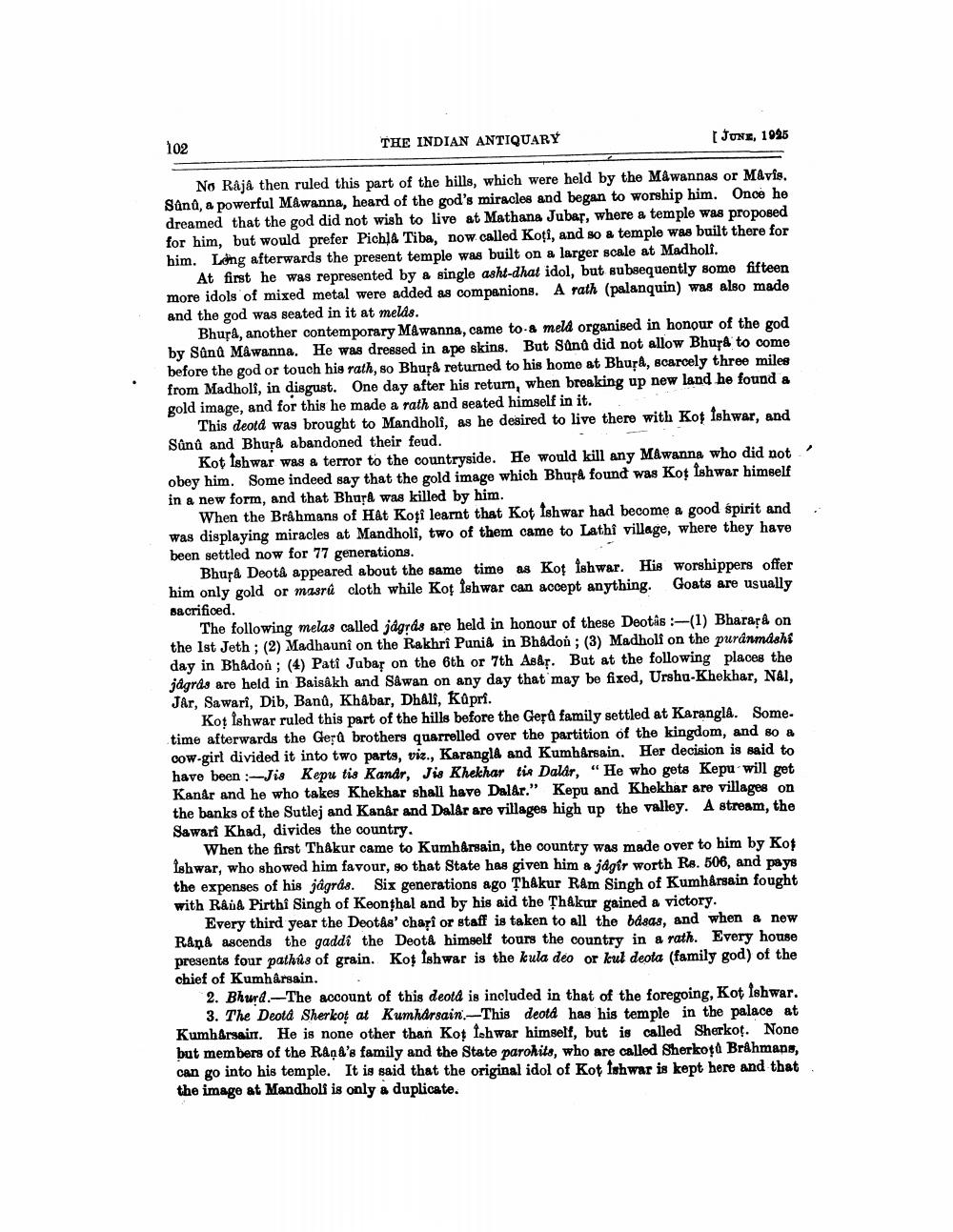________________
102
THE INDIAN ANTIQUARY
JUNE, 1995
No Raja then ruled this part of the hills, which were held by the Mawannas or Mavis. Sûn û, a powerful Mawanna, heard of the god's miracles and began to worship him. Once he dreamed that the god did not wish to live at Mathana Jubas, where a temple was proposed for him, but would prefer Pich]A Tiba, now called Koti, and so a temple was built there for him. Long afterwards the present temple was built on a larger scale at Madholf.
At first he was represented by a single asht-dhat idol, but subsequently some fifteen more idols of mixed metal were added as companions. A rath (palanquin) was also made and the god was seated in it at melas.
Bhusa, another contemporary M&wanna, came to-& meld organised in honour of the god by Sûna Mawanna. He was dressed in ape skins. But Sand did not allow Bhupa to come before the god or touch his rath, so Bhurâ returned to his home at Bhusa, scarcely three miles from Madholi, in disgust. One day after his return, when breaking up new land he found a gold image, and for this he made a rath and seated himself in it.
This deota was brought to Mandholí, as he desired to live there with Kot Ishwar, and Sûn û and Bhura abandoned their feud.
Kot Ishwar was a terror to the countryside. He would kill any Mawanna who did not obey him. Some indeed say that the gold image which Bhuså found was Kot Ishwar himself in a new form, and that Bhus was killed by him.
When the Brahmans of Hat Koti learnt that Kot Ishwar had become a good spirit and was displaying miracles at Mandholi, two of them came to Lathi village, where they have been settled now for 77 generations.
Bhura Deotâ appeared about the same time as Kot Ishwar. His worshippers offer him only gold or masrû cloth while Kog Ishwar can accept anything. Goats are usually Bacrificed.
The following melas called jdgrds are held in honour of these Deotas :-(1) Bharare on the 1st Jeth ; (2) Madhauni on the Rakhri Puniâ in Bhadon ; (3) Madholi on the puranmdshi day in Bhadon ; (4) Pati Jubar on the 6th or 7th As&ş. But at the following places the jdgrds are held in Baisakh and Sawan on any day that may be fixed, Urshu-Khekhar, NAI, JAr, Sawari, Dib, Banú, Khabar, Dhali, kapri.
Kot Ishwar ruled this part of the hills before the Gera family settled at Karangla. Some. time afterwards the Gera brothers quarrelled over the partition of the kingdom, and so a cow-girl divided it into two parts, viz., Karangla and Kumharsain. Her decision is said to have been :-Jis Kepu tis Kandr, Jis Khekhar tie Dalar, “He who gets Kepu will get Kanár and he who takes Khekhar shall have Dalar." Kepu and Khekhar are villages on the banks of the Sutlej and Kanar and Dalar are villages high up the valley. A stream, the Sawari Khad, divides the country.
When the first Thakur came to Kumh&rsain, the country was made over to him by Kot Ishwar, who showed him favour, 80 that State has given him a jdgir worth Rs. 506, and pays the expenses of his jágrds. Six generations ago Thakur Ram Singh of Kumhårsain fought with RAÚA Pirthi Singh of Keonghal and by his aid the Thakur gained a victory.
Every third year the Deotâs' chari or staff is taken to all the basas, and when a new Rand ascends the gaddi the Deotå himself tours the country in a rath. Every house presents four pathies of grain. Kog Ishwar is the kula deo or kul deota (family god) of the chief of Kumhârsain. .
2. Bhurd.The account of this deotd is included in that of the foregoing, Kot Ishwar.
3. The Deota Sherko at Kumharsain.--This deotd has his temple in the palace at KumhArsairr. He is none other than Kot Ishwar himself, but is called Sherkot. None but members of the Raņa's family and the State parohits, who are called Sherkota Brahmans, can go into his temple. It is said that the original idol of Kot Ishwar is kept here and that the image at Mandholi is only a duplicate.




